
Castile and León is an autonomous community in northwestern Spain. It was created in 1983 by merging the provinces of the historic region of León: León, Zamora and Salamanca, with those of Old Castile : Ávila, Burgos, Palencia, Segovia, Soria and Valladolid. The provinces of Santander and Logroño, which until then had been included in the "Old Castile" administrative division, opted out of this merger and formed the new Autonomous Communities of Cantabria and La Rioja respectively. Condado de Treviño and La Puebla de Arganzón, the two municipalities that make up the Treviño enclave, are geographically surrounded by the neighboring Basque Country Autonomous Community, but belong to Castile and León.

Salamanca is a province of western Spain, in the western part of the autonomous community of Castile and León. It is bordered by the provinces of Zamora, Valladolid, Ávila, and Cáceres, and on the west by Portugal. It has an area of 12,349 km2 and in 2018 had a population of 331,473 people. It is divided into 362 municipalities, 11 comarcas, 32 mancomunidades and five judicial districts. Of the 362 municipalities, more than half are villages with fewer than 300 people.

León is a province of northwestern Spain in the northern part of the Region of León and in the northwestern part of the autonomous community of Castile and León.
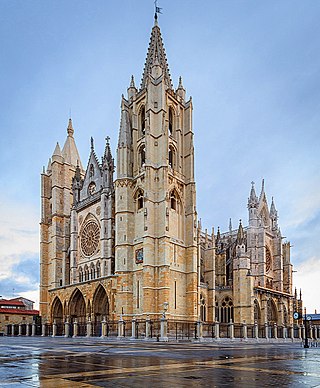
León is a city and municipality of Spain, capital of the province of León, part of the autonomous community of Castile and León, in the northwest of the Iberian Peninsula. It has a population of 124,303 (2019), by far the largest municipality in the province. The population of the metropolitan area, including the neighbouring San Andrés del Rabanedo and other smaller municipalities, accounts for around 200,000 inhabitants.
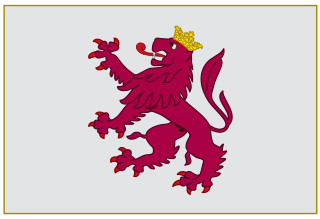
The Kingdom of León was an independent kingdom situated in the northwest region of the Iberian Peninsula. It was founded in 910 when the Christian princes of Asturias along the northern coast of the peninsula shifted their capital from Oviedo to the city of León. The kings of León fought civil wars, wars against neighbouring kingdoms, and campaigns to repel invasions by both the Moors and the Vikings, all in order to protect their kingdom's changing fortunes.

Ledesma is a town in the province of Salamanca (Spain). According to the 2016 census there are 1,767 inhabitants. The municipality of Ledesma includes rural land and covers a total of 141.22 km2 (54.53 sq mi). Its altitude is 730 metres (2,400 ft) above sea level. Its Spanish postal code is 37100.

The Leonese People's Union is a regional political party in Castilla y León, Spain. UPL strives to establish a separate autonomous community for the provinces of León, Zamora and Salamanca, now in the Autonomous Community of Castilla y León. Such a movement is known as Leonesism.
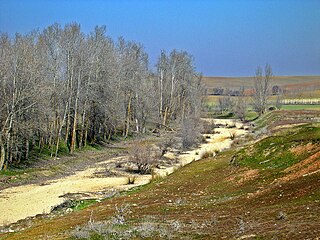
The Trabancos is a river in Spain that flows between the Zapardiel and the Guareña rivers, and is a tributary of the Duero river. The source of the Trabancos is in Moraña, a region in the north of the province of Ávila, near Blascomillán. The Trabancos is at an elevation of approximately 1,100 metres (3,600 ft), is approximately 85 kilometres (53 mi) long and, although its river bed is stable, only has a constant water flow during and immediately after torrential rains.
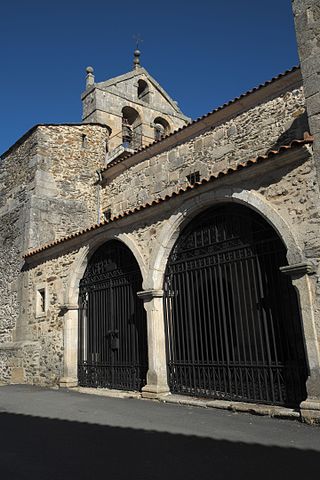
Alcañices is a small town in the province of Zamora, Spain. It is very close to the Portugal-Spain border, not far from the Portuguese town of Bragança. In fact, the Village is especially remembered for being the seat of the Treaty of Alcañices that on 12 September 1297 defined the border between Portugal and the Crown of Castile, the oldest in Europe.

San Esteban de la Sierra is a village and municipality in the province of Salamanca, western Spain, part of the autonomous community of Castile-Leon. It is located 65 kilometres from the provincial capital city of Salamanca and has a population of 340 people.

La Mata de Ledesma is a village and municipality in the province of Salamanca, western Spain, part of the autonomous community of Castile-Leon. It is located 30 kilometres (19 mi) from the provincial capital city of Salamanca and has a population of 110 people.
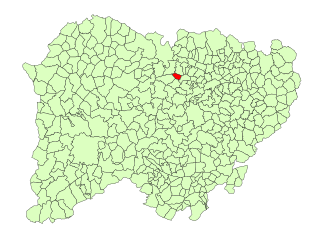
Golpejas is a village and municipality in the province of Salamanca, western Spain, part of the autonomous community of Castile-Leon. It is located 22 kilometres (14 mi) from the provincial capital city of Salamanca and has a population of 155 people.

The Leonese are a subgroup of Spaniards, native to León in Spain.

Valencia de Don Juan is a municipality located in the province of León, Castile and León, Spain. In 2023, the municipality had a population of 5,185.

Lubián is a municipality located in the province of Zamora, Castile and León, Spain. According to the 2018 census (INE), the municipality has a population of 302 inhabitants. It is one of the few bilingual municipalities in the province con Zamora. Its inhabitants habitually use Spanish as well as Galician.

Sanchón de la Ribera is a municipality located in the province of Salamanca, Castile and León, Spain. As of 2016 the municipality has a population of 78 inhabitants.

The Region of León, Leonese region or Leonese Country is a historic territory defined by the 1833 Spanish administrative organisation. The Leonese region encompassed the provinces of Salamanca, Zamora, and León, now part of the modern Spanish autonomous community of Castile and León. As is the case with other historical regions, and continuing with centuries of history, the inhabitants of the Leonese region are still called Leonese. Even today, according with official autonomous government, the historical territorial adjective is used in addition with the modern annexed territory, the rest of Old Castile, being "Castilians and Leonese".
Content in this edit is translated from the existing Spanish Wikipedia article at Iglesia de Sancti Spiritus (Salamanca); see its history for attribution.
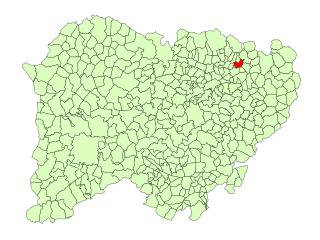
Villaverde de Guareña is a Spanish municipality of the province of Salamanca, in the autonomous community of Castile and León. It is in the district of La Armuña. It belongs to the Judicial district of Salamanca and the commonwealth of La Armuña.
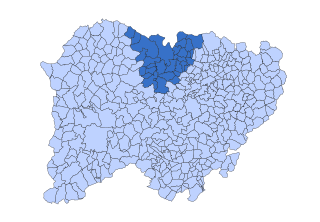
Tierra de Ledesma is a comarca in the province of Salamanca, Castile and León. It contains 30 municipalities: Aldearrodrigo, Almenara de Tormes, Añover de Tormes, Doñinos de Ledesma, Encina de San Silvestre, El Arco, Gejuelo del Barro, Golpejas, Juzbado, La Mata de Ledesma, Ledesma, Monleras, Palacios del Arzobispo, Rollán, San Pedro del Valle, San Pelayo de Guareña, Sando, Santa María de Sando, Santiz, Sardón de los Frailes, Tabera de Abajo, Tremedal de Tormes, Valdelosa, Vega de Tirados, Villarmayor, Villasdardo, Villaseco de los Gamitos, Villaseco de los Reyes, Zamayón and Zarapicos.






















